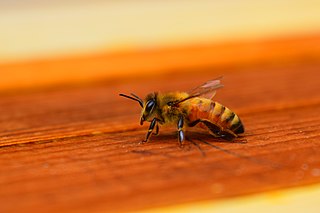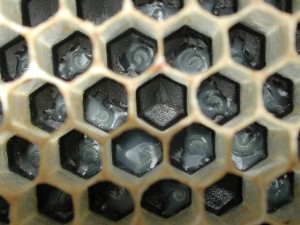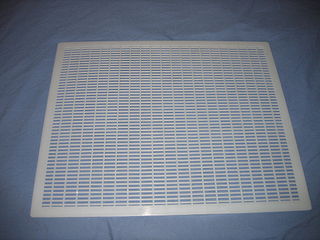
A honey bee is a eusocial, flying insect within the genus Apis of the bee clade. They are known for construction of perennial, colonial nests from wax, for the large size of their colonies, and for their surplus production and storage of honey, distinguishing their hives as a prized foraging target of many animals, including honey badgers, bears and human hunter-gatherers. In the early 21st century, only seven species of honey bee are recognized, with a total of 44 subspecies, though historically seven to eleven species are recognized. The best known honey bee is the Western honey bee which has been domesticated for honey production and crop pollination; modern humans also value the wax for candlemaking and other crafts. Honey bees represent only a small fraction of the roughly 20,000 known species of bees. Some other types of related bees produce and store honey and have been kept by humans for that purpose, including the stingless honey bees, but only members of the genus Apis are true honey bees. The study of bees, which includes the study of honey bees, is known as melittology.

A beekeeper is a person who keeps honey bees.

The honey bee life cycle, here referring exclusively to the domesticated Western honey bee, depends greatly on their social structure.

In beekeeping, bee brood or brood refers to the eggs, larvae and pupae of honeybees. The brood of Western honey bees develops within a bee hive. In man-made, removable frame hives, such as Langstroth hives, each frame which is mainly occupied by brood is called a brood frame. Brood frames usually have some pollen and nectar or honey in the upper corners of the frame. The rest of the brood frame cells may be empty or occupied by brood in various developmental stages. During the brood raising season, the bees may reuse the cells from which brood has emerged for additional brood or convert it to honey or pollen storage. Bees show remarkable flexibility in adapting cells to a use best suited for the hive's survival.
Nosema apis is a microsporidian, a small, unicellular parasite recently reclassified as a fungus that mainly affects honey bees. It causes nosemosis, also called nosema, which is the most common and widespread disease of adult honey bee diseases. The dormant stage of N. apis is a long-lived spore which is resistant to temperature extremes and dehydration, and cannot be killed by freezing the contaminated comb. Nosemosis is a listed disease with the Office International des Epizooties (OIE).

In beekeeping, the queen excluder is a selective barrier inside the beehive that allows worker bees but not the larger queens and drones to traverse the barrier. Queen excluders are also used with some queen breeding methods. Some beekeepers believe that excluders lead to less efficient hives.

A hive frame or honey frame is a structural element in a beehive that holds the honeycomb or brood comb within the hive enclosure or box. The hive frame is a key part of the modern movable-comb hive. It can be removed in order to inspect the bees for disease or to extract the excess honey.

The brood comb is the beeswax structure of cells where the queen bee lays eggs. It is the part of the beehive where a new brood is raised by the colony. During the summer a good queen may lay 1500-2000 eggs per day, which results in 1500-2000 bees hatching after the three-week development period.

Swarming is the process by which a new honey bee colony is formed when the queen bee leaves the colony with a large group of worker bees. In the prime swarm, about 60% of the worker bees leave the original hive location with the old queen. This swarm can contain thousands to tens of thousands of bees. Swarming is mainly a spring phenomenon, usually within a two- or three-week period depending on the locale, but occasional swarms can happen throughout the producing season. Secondary afterswarms may happen but are rare. Afterswarms are usually smaller and are accompanied by one or more virgin queens. Sometimes a beehive will swarm in succession until it is almost totally depleted of workers.

A laying worker bee is a worker bee that lays unfertilized eggs usually in the absence of a queen bee. Only drones develop from the eggs of laying worker bees. A beehive cannot survive with only a laying worker bee.
Hive management in beekeeping refers to intervention techniques that a beekeeper may perform to ensure hive survival and to maximize hive production. Hive management techniques vary widely depending on the objectives.

Nucs, or nucleus colonies, are small honey bee colonies created from larger colonies. The term refers both to the smaller size box and the colony of honeybees within it. The name is derived from the fact that a nuc hive is centered on a queen, the nucleus of the honey bee colony.

Stingless bees, sometimes called stingless honey bees or simply meliponines, are a large group of bees, comprising the tribe Meliponini. They belong in the family Apidae, and are closely related to common honey bees, carpenter bees, orchid bees, and bumblebees. Meliponines have stingers, but they are highly reduced and cannot be used for defense, though these bees exhibit other defensive behaviors and mechanisms. Meliponines are not the only type of "stingless" bee; all male bees and many female bees of several other families, such as Andrenidae, also cannot sting.

Bombus terrestris, the buff-tailed bumblebee or large earth bumblebee, is one of the most numerous bumblebee species in Europe. It is one of the main species used in greenhouse pollination, and so can be found in many countries and areas where it is not native, such as Tasmania. Moreover, it is a eusocial insect with an overlap of generations, a division of labor, and cooperative brood care. The queen is monandrous which means she mates with only one male. B. terrestris workers learn flower colors and forage efficiently.
A mating yard is a term for an apiary which consists primarily of queen mating nucs and hives which raise drones. A queen bee must mate in order to lay fertilized eggs, which develop into workers and other queens, which are both female. Queens can lay eggs parthenogenetically, but these will always develop into drones (males).
A Cloake Board is a special piece of equipment used in beekeeping to facilitate raising queen bees. Invented by Harry Cloake, the cloake board, or floor without a floor, consists of a queen excluder mounted to a wooden frame. The wooden frame contains a slot which allows a "temporary" floor to be inserted.

The western honey bee or European honey bee is the most common of the 7–12 species of honey bee worldwide. The genus name Apis is Latin for "bee", and mellifera is the Latin for "honey-bearing", referring to the species' production of honey.

Bombus fervidus, the golden northern bumble bee or yellow bumblebee, is a species of bumblebee native to North America. It has a yellow-colored abdomen and thorax. Its range includes the North American continent, excluding much of the southern United States, Alaska, and the northern parts of Canada. It is common in cities and farmland, with populations concentrated in the North Eastern part of the United States. It is similar in color and range to the American bumblebee. It has complex behavioral traits, which include a communication system that involves dancing and a coordinated nest defense to ward off predators. B. fervidus is an important pollinator, so recent population decline is a particular concern.




















